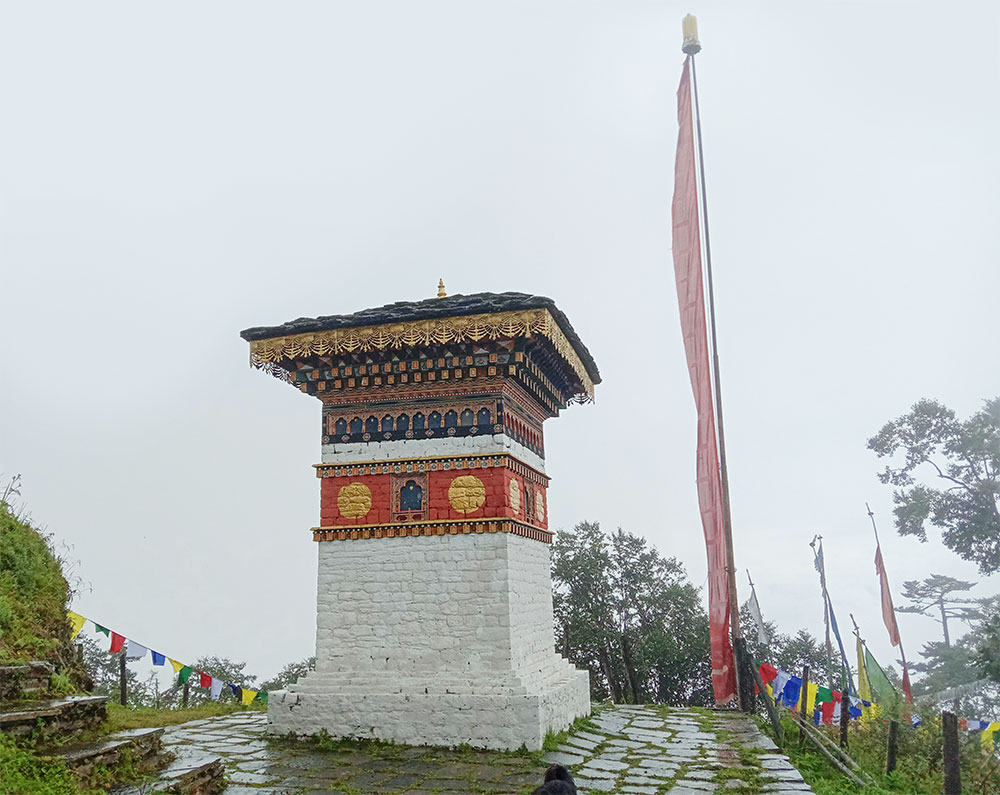KP Sharma
Amidst the soaring ambitions of Bhutanese individuals flocking abroad in pursuit of educational and professional growth, a poignant shift is being witnessed—resurgence of interest in spiritual guidance and cultural roots.
This yearning for balance on the path to realising personal goals has ignited a remarkable trend, infusing Bhutan’s emigrant community with a profound reverence for the nation’s spiritual heritage.
Standing prominently within this evolving narrative is Lungchutse, a hallowed hilltop that has woven itself into the fabric of Bhutanese aspirations.
Among the scattered throng of residents and visitors, the hill’s elevation of 3,569 metres above sea level belies its celestial significance. It houses a revered lhakhang, a sacred choeten, and a contemplative crematorium—a triad of historical emblems, each recounting its distinct tale.
Embarking on a pilgrimage to Lungchutse demands a two-hour ascent from the Druk Wangyel Choeten in Dochula. The journey unfolds through a verdant tapestry of rhododendrons, juniper trees, and an untamed chorus of fungi and avian life. All the while, multicoloured prayer flags dance in symphony with the winds, guiding travelers along a path where nature and spirituality entwine in harmonious companionship.
The culmination of this poetic journey is the revered temple, a testament to Tertoen Drukdra Dorji’s artistry. Constructed over the span of the seventeenth to eighteenth centuries, this sanctum enshrines the transcendent Guru Padmasambhava, or Guru Nga-drama, as its central luminary. The historical significance of Tertoen Drukdra Dorji further extends—a revered Buddhist sage whose prophetic wisdom foretold the birth and reign of Bhutan’s Fourth King, etching His name into the very annals of Bhutanese destiny.
But beneath the temple’s grandeur lies the wish-fulfilling choeten, a modest yet potent monument constructed in 2003. Fashioned under the watchful gaze of Her Majesty Queen Mother Dorji Wangmo Wangchuck, it is whispered to cradle relics of Punakha Dzong. To partake in its blessings, the faithful circumambulate its circumference nine times, each step etching their aspirations into the ether. And so, the collective faith in the choeten’s benevolence kindles a steady stream of pilgrims and visitors, their hopes bound to its ancient stone.
Adjacent to this tapestry of faith stands a crematorium—understated repository of reverence and memory. Here, Tertoen Drukdra Dorji paid his final respects to his mother, further weaving the threads of connection between Lungchutse’s sacred locales.
Yet, as spiritual yearning and cultural reconnection flourish, so do challenges. The hill’s burgeoning popularity ushers in concerns of water scarcity and waste management.
Lam Ugyen Penjor’s voice resonates, detailing the uphill battle faced by water pumps on rugged terrain. Rainwater collection offers a temporary salve, as the lhakhang strives to extend Bhutanese hospitality amidst parched constraints.
In the ongoing story of Lungchutse, community-driven solutions unfold. Volunteer groups and scouts shoulder the mantle of cleanliness. The path to Lungchutse itself finds a guardian in Wind Horse Tours, their dedication extending beyond maintenance to cultivating an environment primed for contemplation.
The ethereal hush that envelops Lungchutse beckons meditation, a sentiment mirrored in the tsham khang—a sanctuary of inner reflection that complements the journey’s external voyage. The rhythm of trumpets and drums punctuates auspicious days and Buddhist occasions, as the lhakhang resonates with the cadence of devotion and ritual.
Within Lungchutse’s hallowed enclave, Zhung Dratsang watches over its legacy. Six souls, lams and tshampas, dwell within its precincts, preserving not just the temple’s physical structure, but its spiritual resonance—harmonic blend of Bhutan’s heritage, contemporary dynamism, and boundless aspirations.
As you tread the path to Lungchutse, the stories of those who ascended before you are borne upon the winds. It’s more than an ascent—it’s a journey to the heart of Bhutan’s spirit, a pilgrimage that converges past, present, and future.


